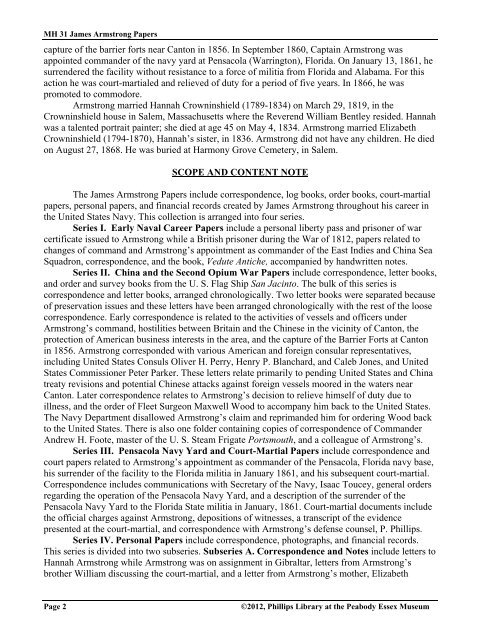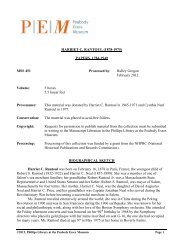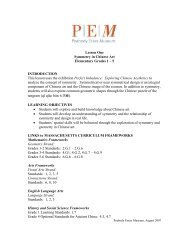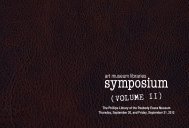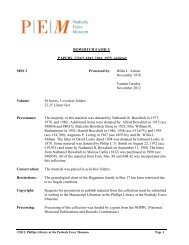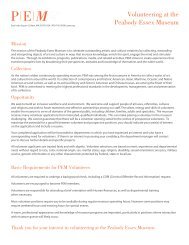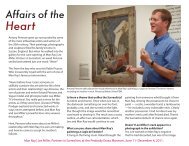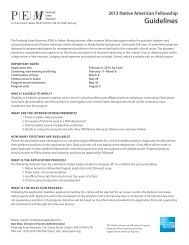Finding Aid - Peabody Essex Museum
Finding Aid - Peabody Essex Museum
Finding Aid - Peabody Essex Museum
You also want an ePaper? Increase the reach of your titles
YUMPU automatically turns print PDFs into web optimized ePapers that Google loves.
MH 31 James Armstrong Papers<br />
capture of the barrier forts near Canton in 1856. In September 1860, Captain Armstrong was<br />
appointed commander of the navy yard at Pensacola (Warrington), Florida. On January 13, 1861, he<br />
surrendered the facility without resistance to a force of militia from Florida and Alabama. For this<br />
action he was court-martialed and relieved of duty for a period of five years. In 1866, he was<br />
promoted to commodore.<br />
Armstrong married Hannah Crowninshield (1789-1834) on March 29, 1819, in the<br />
Crowninshield house in Salem, Massachusetts where the Reverend William Bentley resided. Hannah<br />
was a talented portrait painter; she died at age 45 on May 4, 1834. Armstrong married Elizabeth<br />
Crowninshield (1794-1870), Hannah’s sister, in 1836. Armstrong did not have any children. He died<br />
on August 27, 1868. He was buried at Harmony Grove Cemetery, in Salem.<br />
SCOPE AND CONTENT NOTE<br />
The James Armstrong Papers include correspondence, log books, order books, court-martial<br />
papers, personal papers, and financial records created by James Armstrong throughout his career in<br />
the United States Navy. This collection is arranged into four series.<br />
Series I. Early Naval Career Papers include a personal liberty pass and prisoner of war<br />
certificate issued to Armstrong while a British prisoner during the War of 1812, papers related to<br />
changes of command and Armstrong’s appointment as commander of the East Indies and China Sea<br />
Squadron, correspondence, and the book, Vedute Antiche, accompanied by handwritten notes.<br />
Series II. China and the Second Opium War Papers include correspondence, letter books,<br />
and order and survey books from the U. S. Flag Ship San Jacinto. The bulk of this series is<br />
correspondence and letter books, arranged chronologically. Two letter books were separated because<br />
of preservation issues and these letters have been arranged chronologically with the rest of the loose<br />
correspondence. Early correspondence is related to the activities of vessels and officers under<br />
Armstrong’s command, hostilities between Britain and the Chinese in the vicinity of Canton, the<br />
protection of American business interests in the area, and the capture of the Barrier Forts at Canton<br />
in 1856. Armstrong corresponded with various American and foreign consular representatives,<br />
including United States Consuls Oliver H. Perry, Henry P. Blanchard, and Caleb Jones, and United<br />
States Commissioner Peter Parker. These letters relate primarily to pending United States and China<br />
treaty revisions and potential Chinese attacks against foreign vessels moored in the waters near<br />
Canton. Later correspondence relates to Armstrong’s decision to relieve himself of duty due to<br />
illness, and the order of Fleet Surgeon Maxwell Wood to accompany him back to the United States.<br />
The Navy Department disallowed Armstrong’s claim and reprimanded him for ordering Wood back<br />
to the United States. There is also one folder containing copies of correspondence of Commander<br />
Andrew H. Foote, master of the U. S. Steam Frigate Portsmouth, and a colleague of Armstrong’s.<br />
Series III. Pensacola Navy Yard and Court-Martial Papers include correspondence and<br />
court papers related to Armstrong’s appointment as commander of the Pensacola, Florida navy base,<br />
his surrender of the facility to the Florida militia in January 1861, and his subsequent court-martial.<br />
Correspondence includes communications with Secretary of the Navy, Isaac Toucey, general orders<br />
regarding the operation of the Pensacola Navy Yard, and a description of the surrender of the<br />
Pensacola Navy Yard to the Florida State militia in January, 1861. Court-martial documents include<br />
the official charges against Armstrong, depositions of witnesses, a transcript of the evidence<br />
presented at the court-martial, and correspondence with Armstrong’s defense counsel, P. Phillips.<br />
Series IV. Personal Papers include correspondence, photographs, and financial records.<br />
This series is divided into two subseries. Subseries A. Correspondence and Notes include letters to<br />
Hannah Armstrong while Armstrong was on assignment in Gibraltar, letters from Armstrong’s<br />
brother William discussing the court-martial, and a letter from Armstrong’s mother, Elizabeth<br />
Page 2<br />
©2012, Phillips Library at the <strong>Peabody</strong> <strong>Essex</strong> <strong>Museum</strong>


